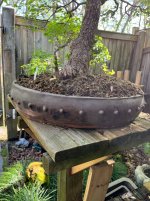I have been looking at pots just as much as the plants and I have tried to determine what makes pots exceptional compared to okay.
I don't mean how it complements a plant, just how the pot looks. I also realize that an exceptional pot does not make an okay tree look better and will pull your eye to the pot and not the tree.
I guess it's because I see so many posts listing the maker ... "x plant in a so and so pot."
(I have been looking at trees for over 40 years, but I just started my first ceramics class .)
.)
I have watched too many youtube videos on making pots to see what I like. Slabs, coils, smooth, rough, textured, ornamented in clay and painted.
Thanks to those of you that have shared your processes on this site. I have tried several.
I don't mean how it complements a plant, just how the pot looks. I also realize that an exceptional pot does not make an okay tree look better and will pull your eye to the pot and not the tree.
I guess it's because I see so many posts listing the maker ... "x plant in a so and so pot."
(I have been looking at trees for over 40 years, but I just started my first ceramics class
I have watched too many youtube videos on making pots to see what I like. Slabs, coils, smooth, rough, textured, ornamented in clay and painted.
Thanks to those of you that have shared your processes on this site. I have tried several.



